Latin America during World War II
The history of Latin America during World War II is important because of the significant economic, political, and military changes that occurred throughout much of the region as a result of the war. The war caused significant panic in Latin America over economics as a large portions of economy of the region depended on the European investment capital, which was shut down. Latin America tried to stay neutral but the warring countries were endangering their neutrality. Most countries used propaganda to turn the neutral countries to their side, while Berlin wanted Latin America neutral. [1] In order to better protect the Panama Canal, combat Axis influence, and optimize the production of goods for the war effort, the United States through Lend-Lease and similar programs greatly expanded its interests in Latin America, resulting in large-scale modernization and a major economic boost for the countries that participated.[2]
| Latin America during World War II | |
|---|---|
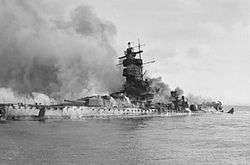 Following the Battle of the River Plate, the German pocket battleship Admiral Graf Spee was scuttled by her crew off Montevideo, Uruguay, on December 17, 1939. | |
| Location | Latin America |
| Date | 1939–1945 |
| Events | The St. Louis Affair – June 1939 Battle of the River Plate – December 13, 1939 Operation Bolivar begins – May 1940 The Lüning Affair – August 1942 The sinking of U-176 – May 15, 1943 Revolution of '43 – June 4, 1943 The Strike of Fallen Arms – May 5–11, 1944 The Panama Canal strike – June 1945 |
Strategically, Panama was the most important Latin American nation for the Allies because of the Panama Canal, which provided a link between the Atlantic and Pacific Oceans that was vital to both commerce and defense. Brazil was also of great importance because of its having the closest point in the Americas to Africa where the Allies were actively engaged in fighting the Germans and Italians. For the Axis, the Southern Cone nations of Argentina and Chile were where they found most of their support, and they utilized it to the fullest by interfering with internal affairs, conducting espionage, and distributing propaganda.[2][3]
Brazil was the only country to send troops to the European Theater; however, several countries had skirmishes with German U-Boats and cruisers in the Caribbean and South Atlantic. Mexico sent a fighter squadron of 300 volunteers to the Pacific, the Escuadrón 201, known as the Aztec Eagles (Águilas Aztecas).
The Brazilian active participation on the battlefield in Europe was divined after the Casablanca Conference. The President of the U.S., Franklin D. Roosevelt on his way back from Morocco met the President of Brazil, Getulio Vargas, in Natal, Rio Grande do Norte, this meeting is known as the Potenji River Conference, and defined the creation of the Brazilian Expeditionary Force.
History
United States role
In 1940, after he expressed his concern to President Franklin D. Roosevelt over Nazi influence in Latin America, Nelson Rockefeller of the famous family was appointed to the new position of Coordinator of Inter-American Affairs (CIAA) in the Office of the Coordinator of Inter-American Affairs (OCIAA).[5][6] Rockefeller was charged with overseeing a program of U.S. cooperation with the nations of Latin America to help raise the standard of living, to achieve better relations among the nations of the western hemisphere, and to counter rising Nazi influence in the region.[7] He facilitated this form of cultural diplomacy by collaborating with the Director of Latin American Relations at the CBS radio network Edmund A. Chester.[8]
Anti-fascist propaganda was a major U.S. project across Latin America, and was run by Rockefeller's office. It spent millions on radio broadcasts and motion pictures, hoping to reach a large audience. Madison Avenue techniques generated a push back in Mexico, especially, where well-informed locals resisted heavy-handed American influence.[9] Nevertheless, Mexico was a valuable ally in the war. A deal was reached whereby 250,000 Mexican citizens living in the United States served in the American forces; over 1000 were killed in combat.[10] In addition to propaganda, large sums were allocated for economic support and development. On the whole the Roosevelt policy was a political success, except in Argentina, which tolerated German influence, and refused to follow Washington's lead until the war was practically over.[11][12]
Economics
According to author Thomas M. Leonard, World War II had a major impact on Latin American economies. Many countries were raising prices on their exports so that they could support themselves economically.[1] Following the December 7, 1941 Japanese attack on Pearl Harbor, most of Latin America either severed relations with the Axis powers or declared war on them. As a result, many nations (including all of Central America, the Dominican Republic, Mexico, Chile, Peru, Argentina, and Venezuela) suddenly found that they were now dependent on the United States for trade. The United States' high demand for particular products and commodities during the war further distorted trade. For example, the United States wanted all of the platinum produced in Colombia, all of Chile's copper, and all of Peru's cotton. The parties agreed upon set prices, often with a high premium, but the various nations lost their ability to bargain and trade in the open market.
Shortages of consumer goods and other products were also a problem during the war years. The demands of the American war industry and a scarcity of shipping caused many goods to be unavailable in Latin America, and so the prices for what was available increased. Gasoline and other oil products were expensive and difficult to obtain. Food shortages were a problem in the cities. Ultimately, all of these factors resulted in inflation.[2]
Most of Latin America used the war to their advantage by siding with the United States and receiving aid. Peru, however, was an exception. In Peru, the government placed price controls on various products; hence, its foreign reserves did not increase as much as some of the other Latin American states and it lost badly-needed capital. Argentina, despite its pro-German leanings and its hostility toward the United States, did very well as trade increased rapidly. Panama also benefited economically, mainly because of increased ship traffic and goods passing through the canal.
In Puerto Rico, the alcohol industry boomed because access to European markets ceased. Petroleum-rich Mexico and Venezuela benefitted from the elevated price of oil. Mexico used this commodity to force a deal on its terms with American and European oil companies for the nationalization of its oil industry in 1938. Furthermore, during the war President Manuel Ávila Camacho capitalized on the situation to improve Mexico's bargaining position with the United States.[2]
Lend-Lease
On March 22, 1941, the United States government enacted Lend-Lease, which was a program which gave war materials and other assistance from the United States in exchange for military bases and participation in the defense of the Western Hemisphere. The United Kingdom and other European nations, including their colonies, logically received the majority of the aid, because the chaos of war was much closer to them. Latin America, however, received approximately $400 million in war materials, which was a small fraction compared with what was distributed to the European nations.[13]
Out of all of the Latin American nations, Brazil benefited the most from Lend-Lease during the war, mainly because of its geographical position at the northeastern corner of South America, which allowed for patrolling between South America and West Africa, as well as providing a ferry point for the transfer of American-made war materials to the Allies fighting in North Africa, but also because it was seen as a possible German invasion route that had to be defended. New and favorable trade treaties were signed with the United States, which offered loans and military aid, but of more importance was the drop in competition in Brazil's manufacturing industry. Brazil received three-quarters of the Lend-Lease assistance distributed in Latin America. Ecuador received some, mainly for the building of an airbase in the Galapagos, and both Colombia and the Dominican Republic used Lend-Lease to modernize their militaries in exchange for their participation in the defense of the Panama Canal and the Caribbean sea lanes.[2]
In contrast, Argentina and Chile received very little military aid, because for most of the war neither would heed American demands that they sever all relations with the Axis powers. Peru received some aid, but by 1943 the western coast of South America had lost all strategic significance, because it was so far away from the main theaters of war, and thus Peru lost its immediate justification for Lend-Lease weaponry. The Central American nations suffered a similar fate as Peru. By 1943, the Pan-American Highway, which the United States was building for defense purposes, ceased to be a priority, and so work on the road, as well as military aid, was halted.[2]
According to Leonard, Lend-Lease changed the balance of power in Latin America and "rekindled old rivalries." The Chilean government, for example, was very concerned about its lack of military assistance, not out of fear of an attack by Axis forces, but because it was concerned that Bolivia and Peru might attempt to use their newly acquired weapons to take back territory lost to Chile sixty years before during the War of the Pacific. Ecuador also was unhappy because, at the end of the 1941 Ecuadorian–Peruvian War, it had lost to Peru. Finally, Argentina was threatened by its old rival, Brazil, because of the latter's access to modern American weaponry. Leonard says that the Argentine dictator Juan Perón came to power partially by claiming that he would "redress this change in military status."[2]
Axis activity

At the beginning of World War II, fascism was seen as a positive alternative by some Latin American leaders and groups that were impressed by Germany's Adolf Hitler, Italy's Benito Mussolini, Japan's Emperor Hirohito, Spain's Francisco Franco (even though Spain remained neutral throughout the war) and the fascist dictators of the minor Axis Powers. President Rafael Trujillo of the Dominican Republic, for example, admired Hitler for his style and his militaristic rallies. Similar views were held by Jorge Ubico and Maximiliano Hernández Martínez, the dictators of Guatemala and El Salvador, respectively. According to Leonard, in Brazil, Argentina, and Chile, the strong sense of unity and purpose created by fascism was quite attractive. All three nations had an influential fascist political party . Brazil's Integralists dressed in jackboots and green military-style shirts, and were open admirers of Mussolini.[2]
In the pre-war years the Germans also enjoyed growing economic penetration using strict binational trade agreements to ensure that the economic relationship with various Latin American nations would be equal. Brazil, Mexico, Guatemala, Costa Rica, and the Dominican Republic all had trade agreements with Nazi Germany. Brazil's trade with Germany, for example, doubled between 1933, when Hitler came to power, and 1938, the year before the war began. With the start of the war in September 1939, Axis ships could no longer cross the Atlantic for commerce, and so trade between Latin America and Germany and Italy ceased. Losing trading partners hurt some of the Latin American states, and in most cases the United States was the only country that was able to replace the Germans and Italians.[2]
Almost all of the Latin American states had to respond to Axis espionage activity. Mexico, and to a lesser extent Brazil, cooperated with the United States in shutting down Axis cells. Chile and Argentina, on the other hand, allowed enemy agents to operate in their countries for most of the war, which was a source of considerable discord between the two nations and the United States. Many of the Latin American states also had to deal with large numbers of immigrants from Axis countries. Colombia, for example, had a population of about 4,000 German immigrants in 1941, as well as a small village of Japanese farmers in Cauca. Many of the Germans in Colombia were involved in the air transportation industry as employees of SCADTA, so the United States was concerned that they might be engaged in espionage or even plot to convert civilian aircraft into bombers for an attack against the Panama Canal. As a result, the United States government pressured Colombia into monitoring and interning the immigrants or, in some cases, deporting them to the United States. The same occurred in other Latin American countries as well.[2][2]
The threat of German and Spanish espionage was much more real. Throughout much of the war, the Germans operated spy networks in all of the most prominent countries of the region, including Argentina, Chile, Paraguay, Brazil, Cuba, Mexico, and others. Operation Bolivar, as it was called, was centered on clandestine radio communications from their base in Argentina to Berlin in Germany, but it also utilized Spanish merchant vessels for the shipment of paper-form intelligence back to Europe. The latter was possible because of Spanish cooperation with German intelligence agencies during the war. Although Argentina and Chile eventually "cracked down" on the Axis agents operating in their countries in early 1944, some Bolivar activity continued up until the end of the European war in May 1945.[3]
In addition to German espionage and sabotage in Latin America, the United States was also concerned about Nazi propaganda. For example, Germany's embassy in Guatemala City served as the distribution center for Nazi propaganda in Central America. Prior to the beginning of the war in 1939, the propaganda focused on the superiority of German manufactured goods, and claimed that Germany was the center for scientific research, because it had the "world's most advanced educational system." Between September 1939 and late 1943, the propaganda focused on German victories and the superiority of its military equipment. From Guatemala the propaganda made its way to the German embassies in other countries, often as packages aboard the Salvadoran airline TACA.[14]
Soviet–Latin American relations
Hitler's invasion of June 1941 provoked support and aid for the Soviet Union in many countries in Latin America, generally organized through voluntary organizations or trade unions. Cuba dispatched 40,000 cigars to the Red Army and in October 1942 became the first Latin American country to extend diplomatic recognition to the USSR. The war led to a diplomatic thaw more generally: by 1945, 11 Latin American states, including Colombia, Chile, Argentina and the Central American republics, had normalized relations with Moscow.[15]
At the end of World War II in Europe, Mexican president Manuel Ávila Camacho declared: "Al enterarme del retroceso definitivo del Ejército alemán recuerdo junto con mi país los esfuerzos admirables del heroico pueblo soviético durante los años de la lucha contra las tropas fascistas." (Upon hearing of the final defeat of the German army, I, along with my country, remembered the admirable efforts of the heroic Soviet people during the years of struggle against fascist troops.)[15]
Jewish Passports-El Salvador
While Jews were trying to escape exile in The Axis powers, Colonel José Castellanos Contreras, the Salvadoran Consul General in Geneva, Switzerland, saved 25,000 Jews by providing them with Salvadoran passports which could be used as a form of political asylum. This was however a very quiet and unrecognized part of El Salvador contribution in World War 2.[16]
Gallery
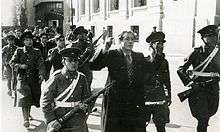 National police escorting members of the National Socialist Movement of Chile during the Seguro Obrero Uprising. On September 5, 1938, after four hours of fighting in Santiago, Chilean authorities rounded up and executed nearly sixty rebels who had surrendered. About twenty others were killed during the fighting.
National police escorting members of the National Socialist Movement of Chile during the Seguro Obrero Uprising. On September 5, 1938, after four hours of fighting in Santiago, Chilean authorities rounded up and executed nearly sixty rebels who had surrendered. About twenty others were killed during the fighting.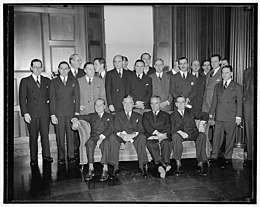 Representatives of Latin American governments and United States retailers during a meeting in Washington, D.C. on November 1, 1939, to discuss a means of increasing trade in the Western Hemisphere.
Representatives of Latin American governments and United States retailers during a meeting in Washington, D.C. on November 1, 1939, to discuss a means of increasing trade in the Western Hemisphere.%2C_February_1940.jpg) President Roosevelt and his Naval Aide, Captain Daniel J. Callaghan, disembarking from USS Tuscaloosa at Gatun Locks, Panama, on February 18, 1940.
President Roosevelt and his Naval Aide, Captain Daniel J. Callaghan, disembarking from USS Tuscaloosa at Gatun Locks, Panama, on February 18, 1940. Soldiers of the American 65th Infantry Regiment in Salinas, Puerto Rico, in August 1941.
Soldiers of the American 65th Infantry Regiment in Salinas, Puerto Rico, in August 1941.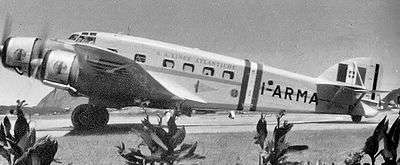 An Italian Savoia-Marchetti SM.81 tri-motor airliner at Howard Field in 1942. This aircraft, which was acquired by the United States from the Italian-Latin American Airline (LATI), was seized in Chile by local government officials and donated to the United States Army because of shortage of transports in Central America.
An Italian Savoia-Marchetti SM.81 tri-motor airliner at Howard Field in 1942. This aircraft, which was acquired by the United States from the Italian-Latin American Airline (LATI), was seized in Chile by local government officials and donated to the United States Army because of shortage of transports in Central America. President Isaías Medina Angarita of Venezuela speaking to Congress during his official state visit to the United States in 1944.
President Isaías Medina Angarita of Venezuela speaking to Congress during his official state visit to the United States in 1944.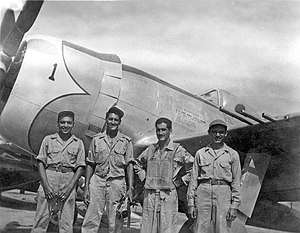 Members of Mexico's 201st Air Fighter Squadron and a P-47 Thunderbolt during the Philippines Campaign in 1945.
Members of Mexico's 201st Air Fighter Squadron and a P-47 Thunderbolt during the Philippines Campaign in 1945. The German submarine U-977 moored at Mar del Plata following her surrender to the Argentine Navy in August 1945.
The German submarine U-977 moored at Mar del Plata following her surrender to the Argentine Navy in August 1945.
See also
- British Empire during World War II
- Argentina during World War II
- Bolivia during World War II
- Brazil during World War II
- Colombia during World War II
- Cuba during World War II
- El Salvador during World War II
- Mexico in World War II
- Panama during World War II
- Paraguay during World War II
- Puerto Ricans in World War II
- Uruguay during World War II
- Venezuela during World War II
References
- "Latin America | International Encyclopedia of the First World War (WW1)". encyclopedia.1914-1918-online.net. Retrieved 2018-12-05.
- Leonard, Thomas M.; John F. Bratzel (2007). Latin America during World War II. Rowman & Littlefield. ISBN 0742537412.
- "Cryptologic Aspects of German Intelligence Activities in South America during World War II" (PDF). David P. Mowry. Archived from the original (PDF) on September 18, 2013. Retrieved August 9, 2013.
- Cary Reich, The Life of Nelson A. Rockefeller: Worlds to Conquer, 1908-1958 (1996), pp 260-373; the standard scholarly biography;
- Cramer, Gisela; Prutsch, Ursula, "Nelson A. Rockefeller's Office of Inter-American Affairs (1940–1946) and Record Group 229", Hispanic American Historical Review 2006 86(4):785–806; doi:10.1215/00182168-2006-050.
- Morris 1960, pp. 129–135
- Time, June 1, 1942
- Kornel Chang, "Muted reception: US propaganda and the construction of Mexican popular opinion during the Second World War." Diplomatic History 38.3 (2013): 569-598.
- Lars Schoultz (2014). National Security and United States Policy Toward Latin America. p. 175.
- Reich, pp 270-75, 305-17.
- Randall B. Woods, "Hull and Argentina: Wilsonian Diplomacy in the Age of Roosevelt" Journal of Interamerican Studies and World Affairs 16#3 (1974) pp. 350-371 online
- Pearcy, Thomas L. (2006). The History of Central America. Greenwood Publishing Group. ISBN 0313322937.
- Leonard, Thomas M. (2011). The History of Honduras. ABC-CLIO. ISBN 0313363048.
- Sizonenko, Alexander (26 April 2015). "América Latina y la URSS en la Segunda Guerra Mundial". Russia Beyond the Headlines. Retrieved 19 December 2015.
- Call to honour El Salvador's rescuer of Jews after war role rediscovered, Rory Carroll, June 2008, The Guardian, retrieved 8 April 2015
Further reading
- Dear, Ian C. B. and Michael Foot, eds. The Oxford Companion to World War II (2005), comprehensive encyclopedia for all countries
- Eccles, Karen E. and Debbie McCollin, eds. World War II and the Caribbean (2017) excerpt
- Lee, Loyd, ed. World War II in Europe, Africa, and the Americas, with General Sources: A Handbook of Literature and Research (1997) excerpt and text search
- Jackson, Ashley. The British Empire and the Second World War (Continuum, 2006). pp 77-95 on Caribbean colonies
- Leonard, Thomas M.; John F. Bratzel Latin America during World War II (Rowman & Littlefield, 2007). ISBN 0742537412.
- McConahay, Mary Jo. The Tango War: The Struggle for the Hearts, Minds and Riches of Latin America During World War II (2018) excerpt
- Eccles, Karen E. and Debbie McCollin, eds. World War II and the Caribbean (2017) excerpt